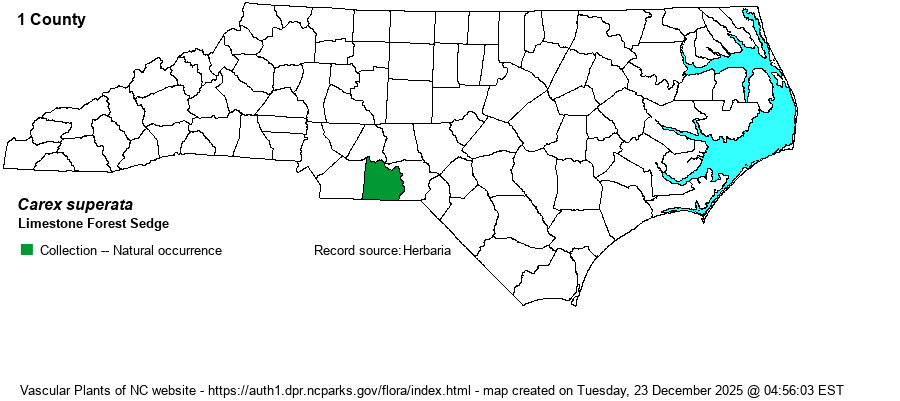| Author | Naczi, Reznicek, & B.A. Ford | |
| Distribution | Lower Piedmont only. The first record for NC was in Anson County, hardwoods on lower slope of Ingram Mountain, 21 April 2010, Sorrie & Naczi 12532 (NCU, NY, MMNS). A second location is also from Anson County: bouldery lower slope by North Fork Smith Creek, 18 April 2008 (NCU) Expected elsewhere in NC, at least near the SC border (as it is known from many counties in that state).
Extreme southwestern VA to KY south to FL and MS. | |
| Abundance | Very rare, so far as is known -- just 2 sites in Anson County. The website editors suggest the NCNHP's S1? State Rank is certainly better as a straight S1. It is a State Threatened species. | |
| Habitat | Mesic hardwoods in circumneutral soils (over mafic rock). Elsewhere, in limestone soils. | |
| Phenology | Flowering and fruiting April-May. | |
| Identification | Plants in the field look like dense tufts of dark green leaves, with flowering stems hidden among the foliage. Compared to C. willdenowii, C. superata has darker green leaves and longer perigynia (7.5-8.9 mm long vs. 4.9-5.7 mm long). | |
| Taxonomic Comments | Described in 1998; formerly included within C. willdenowii as var. megarryncha.
The genus Carex is the largest in North America, and among the largest in the world. In temperate and boreal regions, Carex is often the dominant or co-dominant ground layer in many habitats. Seeds (achenes) are valuable food for birds and small mammals, while foliage is used by birds and mammals to make nests and as food by mammals. Species of Carex often look vastly different from one another -- spikes erect vs. drooping, tiny inflorescence vs. whopping, culms leafy vs. naked, perigynia beaked vs. beakless, stems densely bunched vs. single, etc. The genus has been divided into many sections (or groups), based on shared characters; some taxonomists have suggested that these be different genera, but that proves unworkable (so far). All Carex share the feature of a perigynium (an outer covering) which completely surrounds the achene (seed). This covering may fit tightly or loosely (like a small bladder), depending on which group or species. Details of perigynia shape, ornamentation, presence and size of beak, number of striations (or veins) are all important ID features. In recent years Rob Naczi and colleagues have stressed the importance of arrangement of perigynia -- whether spiral (3+ ranks) or distichous (2-ranked) -- and have named a number of new species as well as split off some older synonyms. Therefore, RAB's (1968) key, excellent for its time, can only be used in a general way today. Members of some sections of Carex are difficult to key out (notably Ovales, Laxiflorae, Griseae); this is in part due to variation among individuals of a species, or failings of the key. FNA has drawings of most species and some species may be found in two or more places within a key, to acount for variability. New species to NC, and new to science(!), continue to be found in NC. | |
| Other Common Name(s) | Some references still use Willdenow's Sedge as the common name, but that is reserved for C. willdenowii. | |
| State Rank | S1? [S1] | |
| Global Rank | G4? | |
| State Status | T | |
| US Status | | |
| USACE-agcp | FAC link |
| USACE-emp | FAC link |

